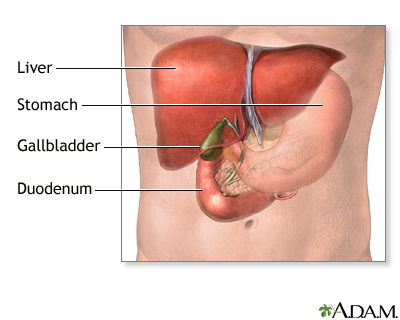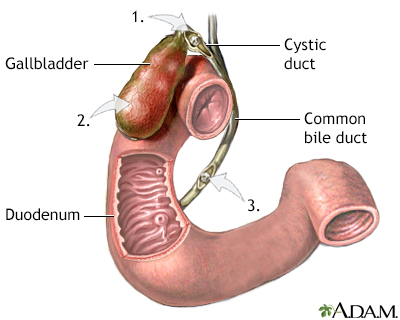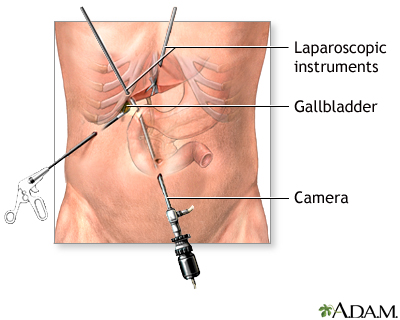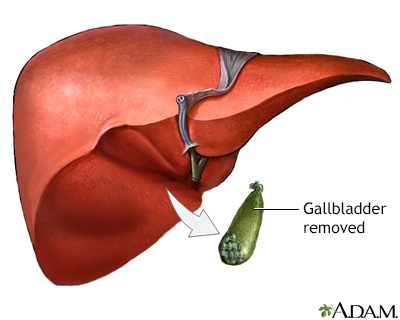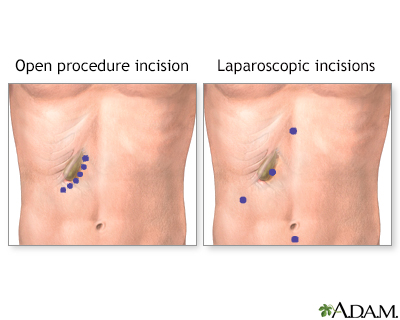Gallbladder removal
Normal anatomy
|
|
The gallbladder is located in the abdomen, on the right side, underneath the liver. The gallbladder stores bile produced by the liver, and delivers it to the first part of the small intestine (duodenum), where it aids in the digestion of fat. The cystic and common bile ducts connect the gallbladder to the duodenum-bile passes through these ducts from the gallbladder to the duodenum.
|
Indications
|
|
Gallbladder surgery is done to treat gallbladder disease. Gallbladder disease is commonly caused by the formation of gallstones in the gallbladder (cholelithiasis). Gallstones can affect different locations.
- Obstruction of the cystic duct leading to severe abdominal pain (biliary colic).
- Infection or inflammation of the gallbladder (cholecystitis).
- Blockage of the biliary ducts leading to the duodenum (biliary obstruction).
In each case, the gallbladder is often removed (cholecystectomy).
|
Incision
|
|
Most gallbladder surgery today is done using laparoscopic surgical techniques, in which narrow instruments, including a camera, are introduced into the abdomen through small puncture holes. If the procedure is expected to be straightforward, laparoscopic cholecystectomy may be used. A laparoscopic camera is inserted into the abdomen near the umbilicus (navel). Instruments are inserted through 2 more small puncture holes. The gallbladder is found, the vessels and tubes are cut, and the gallbladder is removed.
|
Procedure
|
|
If the gallbladder is extremely inflamed, infected, or has large gallstones, the abdominal approach (open cholecystectomy) is recommended. A small incision is made just below the rib cage on the right side of the abdomen. The liver is moved to expose the gallbladder. The vessels and tubes (cystic duct and artery) to and from the gallbladder are cut and the gallbladder is removed. The tube (common bile duct) that drains the digestive fluid (bile) from the liver to the small intestine (duodenum) is examined for blockages or stones. A small flat tube may be left in for several days to drain out fluids if there is inflammation or infection.
|
Aftercare
|
|
Most patients who undergo laparoscopic cholecystectomy can go home the day of surgery or the next day, and resume a normal diet and activities immediately. Most patients who undergo open cholecystectomy require 5 to 7 days of hospitalization, are able to resume a normal diet after one week, and normal activities after 4 to 6 weeks.
|

Review Date:9/9/2023
Reviewed By:Debra G. Wechter, MD, FACS, General Surgery Practice Specializing in Breast Cancer, Virginia Mason Medical Center, Seattle, WA. Also reviewed by David C. Dugdale, MD, Medical Director, Brenda Conaway, Editorial Director, and the A.D.A.M. Editorial team.
The information provided herein should not be used during any medical emergency
or for the diagnosis or treatment of any medical condition. A licensed medical professional
should be consulted for diagnosis and treatment of any and all medical conditions. Call 911
for all medical emergencies. Links to other sites are provided for information only -- they
do not constitute endorsements of those other sites. © 1997-A.D.A.M., Inc. Any duplication or distribution of the information contained herein is strictly prohibited.
The Agency for Health Care Administration (Agency) and this website do not claim the information on, or referred to by, this site is error free. This site may include links to websites of other government agencies or private groups. Our Agency and this website do not control such sites and are not responsible for their content. Reference to or links to any other group, product, service, or information does not mean our Agency or this website approves of that group, product, service, or information.
Additionally, while health information provided through this website may be a valuable resource for the public, it is not designed to offer medical advice. Talk with your doctor about medical care questions you may have.

